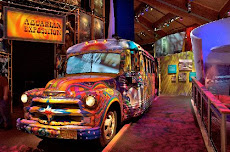
Hi All;
Here is some excellent information for all those who love Vintage Clothes.
Why buy vintage?
Which items are considered collectible?
How do antique garments survive over time?
What changed with vintage clothing at the turn of the century?
The idea of wearing old clothing as new style developed in the late 1960s and early 1970s. By the end of World War II in 1945, clothing factories had learned to mass-produce clothes the same way they are mass-produced now. As more and more types of garments could only be bought off-the-rack, looking just the same as everyone else's wardrobe, people with a creative fashion sense got bored. They wanted unique clothing that didn't have to be expensively custom-made. Thanks to the fashion revolution in the 1960s, clothing became much more varied, and styles from different eras were more widely accepted. People embraced this by scouring thrift shops and yard sales, and vintage clothing stores began opening in the 1970s. Today, we get requests from people who run the gamut- they want one label, a specific era, a certain type of clothing, or a special fabric. There are so many collecting fields, from couture Geoffrey Beene, to beatnik chic, to nylon lingerie and barkcloth prints. Thankfully, clothing preference is most importantly a matter of choice, not trend, and vintage clothing is still going strong in the new century!
Within the last twenty years, a revamp of modern styles has made vintage looks more popular than ever, for better or worse.
More common than many people realize! One reason for this is because several trends, especially in the last half-century, have developed into classics: the shift, the twin set, the basic suit and many more were all created in the last fifty years. They've not drastically changed, and they've been mass produced compared to previous eras. So their classic looks allow vintage clothes to be worn incognito, with only an experienced eye differentiating between whether another person is wearing vintage or contemporary. At the same time, the mass production has left many garments of previous years in great shape and still in their "prime", so the amount of vintage clothing available is enough to create a large and diverse supply. Also, the loosening of fashion codes over the last forty or so years allows more variation of styles to be worn in more settings, paving the way for vintage clothing to be appropriate apparel for many settings.
Chances are, most people don't see a difference between new and vintage clothing, except in noticing high quality or unusual fabrics and tailoring, or extra-ordinary style. For teenagers and twenty or thirty-somethings, vintage clothing is often known and used as a source for one-of-a-kind styles. However, more and more people rely on vintage clothing to add fantastic style to their wardrobe.
Scouring department stores for a garment that is classic or not a fad is hard, and having to pay for new designer clothing can be outrageous. A better, less expensive choice is using clothing that may be an old fashion, but is certainly not out of fashion. After all, what's gone around is always coming into fashion again.
Most people go to malls and department stores today to supply their wardrobes. They sometimes leave frustrated about the low quality and cookie-cutter appearance of most mass-produced garments. Usually, when they need a special dress or outfit, they have a limited range of style choices. Sometimes people buy just to fill that requirement, not because they've really found an item they love.
Vintage clothing is different. It spans clothing styles over the years, so you're more likely to find a style that's really you, whether it be classic or without-a-doubt unique. Also, the usual prices for vintage wearables are easily compared to the sale prices of department store clothing - or lower! Plus, with vintage gear, you get hand tailoring and many quality details. Vintage clothing is often of first-rate quality. Luxurious fabrics and incredible hand-stitchery can be had a fraction of the cost that tailors charge today. Because fashion has not changed dramatically over the past seventy years, older clothing fits today's fashions. Many times, the latest fashion is just a take of a previous style from a previous decade. And wearing a vintage garment is like wearing a made-for-you original: no one else will have the same thing, and you have that special ambience of knowing that your garment has more to it than most people realize.
Lastly, vintage clothing is an investment. Auctions of vintage clothing at Sotheby's and William Doyle normally sell 19th and 20th century pieces for hundreds and thousands of dollars. These items are becoming more scarce as time passes and people recognize that some of their old clothes are rare collectibles. As long your vintage items stay in good condition, they grow in value.
It really all happens when a group of people choose to collect similar items, which in turn become harder to find and increase in value. Here we compare factors of collecting with two items that have become part of the "hot list" for vintage collectors: 1920s beaded gowns and 20th century vintage denim. Value most often means rarity, so a garment type that usually doesn't survive the passing of time is considered valuable. If the heavily beaded silk chiffon dresses of the 1920s were kept hanging in the closet, they pulled themselves apart from their own weight over years. Another rare item is jeanswear, which was strictly utilitarian until the 1940s and 50s. It is now extremely valuable, because most early jeans were worn to "early deaths".
Another facet that makes an item collectible is nostalgia. The 1920s were years of change in society, and the icon of the flapper, in beaded dress and cloche hat, is an irresistable reflection of the era to our culture. Likewise, the rugged durability of denim that was born into jeans as settlers moved west in the 1800s is now a treasured piece of Americana. So both of our examples are rare to find intact, and both a beaded silk 1920s dress and a 1930s denim overall are treasured collectibles. The amount of collectability is determined by a high demand for the item and a relatively scarce supply.
Age is not always the defining indicator, either. A plain handmade linen 1900s skirt would not be particularly desired by most collectors, unless they were specifically seeking working class Edwardian era garments. On the other hand, a 1970s ensemble by Emilio Pucci would be highly desired, since the style and label of Pucci is a widely collected name. Beyond this, there are narrow sub-fields of things collected: 1940s gabardine, western wear, 1960s mini dresses to name a few. The more people there are looking for a certain type of item, the higher the price.
On a second note, types of items that are no longer considered a necessary part of a modern outfit (like gloves or garters) are often collected simply for nostalgia. Though beaded dresses and jeans don't fit this category, "old fashioned" items no longer used are their own subfields for collectors. This includes items such as hats, hatpins, gloves, antique shoes, corsetry, parasols, canes, and countless other accessories, collected for their period charm and growing scarcity.
The answer varies, depending on who the garment belonged to and what conditions the items were kept under. People who are "pack rats"; or "clotheshorses" often save their clothes no matter what the style, age, or size. These items are usually stored in closets or spare rooms, giving them protection from light and temperature changes. However, mildew and pests can flourish if the area is not checked.
Sentimental heirlooms are a second route to preservation. These items are passed on through generations, and this is also a good and bad situation for the garment. Often heirlooms are packed in storage, which has fluctuating temperature, humidity, and opportunity for pests. If the later owner appreciates the item, however, he or she may allow for better storage conditions.
Wardrobes of celebrities and royalty is another, and very productive area, in terms of surviving garments. While museums and collectors cherish and preserve a famous person's clothing, they are also saving a piece of fashion from another era. To show the difference between surviving garments of museums and those of collectors, many museums have a few 1700s gowns as part of their collection. Dealers and collectors rarely find a garment from the early- to mid- 1800s. Though a large number of earlier garments exist, most have been secured by museums for their historic value. For most vintage lovers, items they buy were first worn by unknown people of another age. The garments still in existence were either saved for posterity, somehow not worn often, or simply lucky in surviving the test of time.
Sentimental heirlooms are a second route to preservation. These items are passed on through generations, and this is also a good and bad situation for the garment. Often heirlooms are packed in storage, which has fluctuating temperature, humidity, and opportunity for pests. If the later owner appreciates the item, however, he or she may allow for better storage conditions.
Wardrobes of celebrities and royalty is another, and very productive area, in terms of surviving garments. While museums and collectors cherish and preserve a famous person's clothing, they are also saving a piece of fashion from another era. To show the difference between surviving garments of museums and those of collectors, many museums have a few 1700s gowns as part of their collection. Dealers and collectors rarely find a garment from the early- to mid- 1800s. Though a large number of earlier garments exist, most have been secured by museums for their historic value. For most vintage lovers, items they buy were first worn by unknown people of another age. The garments still in existence were either saved for posterity, somehow not worn often, or simply lucky in surviving the test of time.






No comments:
Post a Comment